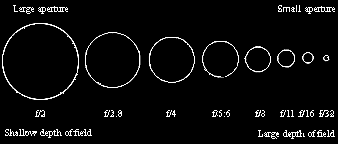|
|
Apertures are controlled by an iris-like diaphragm - see the animation on the right. A series of crescent-shaped blades forms a near-circular hole at the centre of the lens. The diameter of the hole varies as the blades slide over each other under the control of an external ring. The aperture can be varied from a tiny opening a few millimetres in diameter to the maximum diameter of the lens. The aperture control ring is calibrated using a series of standard numbers such as 1.4, 2, 2.8, 4, 5.6, 8, 11, 16, 22 and 32. These numbers are a measure of the lens aperture, known as f-numbers or f-stops, each step on the scale halving or doubling the area of the aperture and hence the amount of light that passes through the lens. Each stop is in fact the number by which the focal length of the lens must be divided to give a particular aperture diameter. For example, in a lens of 200mm focal length, 4 (usually written f/4) represents an aperture diameter of 200/4 = 50mm.
 The beauty of the ratio-based f-stop system is that it is independent of focal length. Lenses can therefore be interchanged without altering exposure settings. A 50mm lens set to f/4 passes the same amount of light as a 300mm lens set to the same aperture. The doubling sequence also complements the parallel scale of shutter speeds. Consequently, changing shutter speed and aperture the same number of steps in opposite directions leaves exposure unchanged - 1/250 second at f/4 gives the same exposure as 1/125 at f/5.6.
The beauty of the ratio-based f-stop system is that it is independent of focal length. Lenses can therefore be interchanged without altering exposure settings. A 50mm lens set to f/4 passes the same amount of light as a 300mm lens set to the same aperture. The doubling sequence also complements the parallel scale of shutter speeds. Consequently, changing shutter speed and aperture the same number of steps in opposite directions leaves exposure unchanged - 1/250 second at f/4 gives the same exposure as 1/125 at f/5.6.






